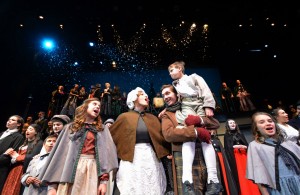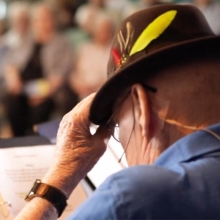Filichia Features: Start Planning for A Christmas Carol
Filichia Features: Start Planning for A Christmas Carol
Adults have differing opinions on politics, religion, sex, money and virtually everything else, but there’s one aspect of life on which they all agree.
Time passes oh-so-swiftly and much-too-quickly.
So start planning your December 2014 production now.
Yes, I know. You’re still getting over this December’s production, not to mention the 2013 holidays with too much food, too many parties and too few relatives who understand you.
Thus, if you spent December putting on a show (as I did), you may not want to think about what you’ll be producing or directing next December. But you must face it: it’ll be here before we know it, and you don’t have all that much time to decide on what your December 2014 audiences will see.
So may we suggest that you soon take a look at the musical version of A Christmas Carol?
You’d certainly have a great hook on which to advertise it: “From the creators of Aladdin, Beauty and the Beast, Little Shop of Horrors, Once on This Island, Ragtime and Seussical.”
For indeed the composer of the first three musicals cited is no less than Alan Menken; the lyricist of the last three is the estimable Lynn Ahrens. She wrote the book with Mike Ockrent, who was an important building block in Big, Crazy for You and Me and My Girl.
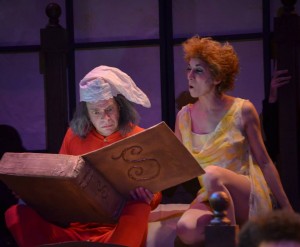
And may your production of A Christmas Carol turn out as splendidly as the one that Michael Blevins recently mounted at Centenary Stage Company in Hackettstown, New Jersey. It was so accomplished that one might have assumed that Blevins had started rehearsals last January. By the end of the show, when Ebenezer Scrooge delivered a Christmas turkey to the Crachits, I was thinking, “Well, Blevins certainly didn’t deliver a Christmas turkey to his audience.”
Much of the success came from his cast of 60 – yes, 60. It’s a great community show, because it offers more cameos than can be found in an Italian jewelry shop. So many people have a line or two, and even those who don’t will have plenty to do in the half-dozen production numbers. Blevins had a fine old time (as did his cast) with “Abundance and Charity,” the Ghost of Christmas Present’s song that allows soft-shoe and tap. Throughout the house, one could hear many friends and relatives enjoying one of musical theater’s most hallowed audience activities: finding the person they know on stage. (“Where’s Waldo? Oh, there he is!”)
With all those cast members, even the enormous stage that Blevins had wasn’t enough. So he used a set that had a two-level bridge with a staircase going up each side. That bridge also let his Ghosts of Past, Present and Future literally come down to earth.
While London shops were seen below on stage left and right, the section in between was an empty square in which little set pieces could slide on and off, starting with the front door of Scrooge’s house. Inside, the fireplace provided Jacob Marley with a nice entrance.
Should you produce the show, you’ll find that furnishing Scrooge’s bedroom won’t be costly. For one thing, the miser had no more than ancient chairs and a modest bed. Anyone on your staff who drives around the streets of your town on garbage day will find enough distressed furniture to give the right look for Scrooge’s digs.
When you’re a theater critic (as I’ve been for most of my working life), you see quite a few productions of A Christmas Carol. The tally thus far is 27 straight-play versions from Massachusetts to Alabama; 11 one-man shows in which an intrepid actor plays everyone from Scrooge to Mrs. Dilber and two that updated the action to the present day – not including my OWN update, Adam's Gifts, which you should look at, too. But that’s literally another story.
But of all I’ve seen, only Ockrent, Ahrens and Menken thought to show an early scene involving Mr. Smythe, one of Scrooge’s borrowers. His mortgage payments are due on the 25th of each month, and Smythe has routinely met his obligations until now. This December, fortune has violently turned against him. (That Blevins had his actor wear unusually long hair was fitting; the implication was that the poor soul couldn’t even afford a haircut.)
And that the 25th of this particular month just happened to be Christmas Day cut not even the thinnest of ice with Scrooge. What a smart way of showing us that this man won’t be easily changed.
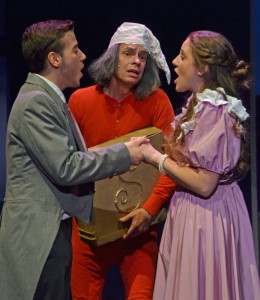
Of course he does change, which is what makes Scrooge such a great role for an actor. He gets to play so many emotions starting from complete cantankerousness and culminating in steam-heat warmth. May you be as blessed as Blevins to have an actor the caliber of Osborn Focht, who carefully calibrated each scintilla of growth. Credit, too, to Focht for being game enough in Scrooge’s first scene at home to be seen in longjohns. Anybody who comes on stage in such underwear is going to be mocked by the audience, and Focht was no exception when he emerged in a red head-to-toe outfit.
The nice roles range from the Fezziwigs down to Young Scrooge. To see that the attractive Jared Cowley became a man who resembled the wrath of God was a powerful stage image that made the tragedy worse. The message was clear: Scrooge became ugly-looking from acting ugly.
And while this may sound a little grisly, in his opening scene where London is revealed in front of us, Bevins had one person on stage wear a sack-like hood over his head to suggest that he was “The Elephant Man.” (Well, Joseph Merrick did live in 19th century London, albeit a little later than the time when A Christmas Carol debuted.)
Start looking now too for a Bob Cratchit who’ll be able to pick up Tiny Tim with ease. The audience must be convinced that this father swoops the lad into his arms and over his head many times each and every day. Have your Bob Cratchit practice until he can make Tiny Tim fly into the air with the greatest of ease. James Nester accomplished this and more: in the scene set on Christmas, Nester’s Cratchit showed an immense appreciation on getting to spend a full day with his beloved family.

A Christmas Carol makes the point that it’s never too late to change. Well, yes and no; theater companies do lock in their schedules quite early and, once the wheels are in motion, find that they can’t change the shows they’ve chosen even if they want to. Settle on A Christmas Carol now, and next December, by the time that The Ghost of Christmas Present appears, every theatergoer will already be feeling that he’s received his own Christmas present.
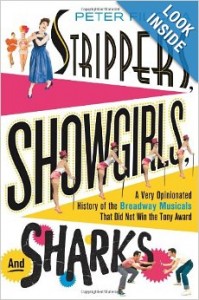
You may e-mail Peter at pfilichia@aol.com. Check out his weekly column each Tuesday at www.masterworksbroadway.com and each Friday at www.kritzerland.com. His new book, Strippers, Showgirls, and Sharks – a Very Opinionated History of the Broadway Musicals That Did Not Win the Tony Award is now available at www.amazon.com.
